BWO HAPPY HOURS - SOLUTION (part 4)
November 1st, I arrived at DePuy's just around noon. Right that moment winds started to blow hard from south and blew away all BWO to Canada. I checked around miscellaneous spots but no hatches and rises were observed. I was so agitated. BWO hatch would end any time soon. I needed to find answers before that. I couldn't imagine how cruel it would be if I might have to live with this paranoia until next fall.
On November 2nd, weather turned out to be very nice. I started fishing with large soft-hackles and egg patterns in the morning and felt some fish. I was so anxious about BWO hatch (hoped for solution but also fear of another defeat). I held a spot at "Bend" again. At 12:30 p.m, trout started feeding just the same manner: rise forms without breaking the film. Soon (about 12:45 p.m) I observed that three trout had positioned themselves and locked in. Again each of them moved barely one-foot of radius from its original position.
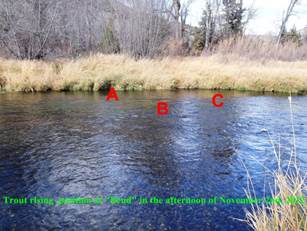
I stuck with dry-nymph combinations (as covered in PART 3) and tried to have them target on nymph patterns. I adjusted the depth of my nymphs by greasing tippets, adjusting tippet length, or using weighted or unweighted patterns. Again my flies were totally ignored. I decided to walk downstream to seine, hoping there might be something other than BWO (such as midge pupae).
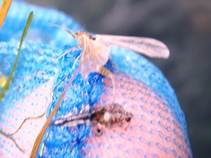 |
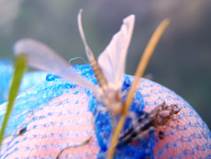 |
Just popped out on my finger! |
"3-second-old" BWO dun |
All I collected were BWO. These pictures were taken on 1:13 p.m = 30 minutes in without any response.
I tried everything I could think of. Trout kept feeding but not on my flies. Time was passing. I really thought about calling Tom Travis to come over and help me. The situation looked desperate and way beyond normal fishing. Should I give up, snap my rod off, throw rocks at trout, and go home?
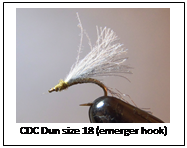 ONE MORE TECHNIQUE LEARNED FROM MASTER ANGLER – TWITCH: I organized what I was observing and experiencing (not to mention, caught some breaths). Trout were not taking duns on the surface (dry-flies). Emergers and ascending nymphs (soft-hackles and suspended nymphs) below the surface were not taken either. All I could think of were drowned duns as I had been seining. How could I fish for that? Then I recalled one more technique Tom taught me – twitch our flies at rise-rings. Twitch is different from swing. It's done by stripping fly-line for an inch or an inch and a half. Originally Tom told me this was to animate mayfly nymphs that are very active and wiggling as they ascend to the surface (that's why simple soft-hackles and PTs can be so deadly). But then again, whether twitched or not, trout were not taking soft-hackles or nymphs below the surface. So, combining all, I decided to twitch my CDC Dun so it would sink below the film to imitate a drowned dun (then I trailed a little soft-hackle behind it, just in case).
ONE MORE TECHNIQUE LEARNED FROM MASTER ANGLER – TWITCH: I organized what I was observing and experiencing (not to mention, caught some breaths). Trout were not taking duns on the surface (dry-flies). Emergers and ascending nymphs (soft-hackles and suspended nymphs) below the surface were not taken either. All I could think of were drowned duns as I had been seining. How could I fish for that? Then I recalled one more technique Tom taught me – twitch our flies at rise-rings. Twitch is different from swing. It's done by stripping fly-line for an inch or an inch and a half. Originally Tom told me this was to animate mayfly nymphs that are very active and wiggling as they ascend to the surface (that's why simple soft-hackles and PTs can be so deadly). But then again, whether twitched or not, trout were not taking soft-hackles or nymphs below the surface. So, combining all, I decided to twitch my CDC Dun so it would sink below the film to imitate a drowned dun (then I trailed a little soft-hackle behind it, just in case).
I aimed at Trout A with the same angle of presentation for dead-drifting dry-flies. Immediately my flies landed on the water surface, I twitched my line. Trout A rose and attacked my fly with the exactly same rise form!! It wasn't on a twitched soft-hackle but on a twitched and drowned CDC Dun!!
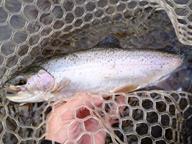 |
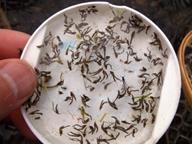 |
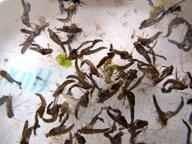 |
| Trout A revealed!! | This seemed only a part of what she had inside….. | Close look. |
A close look of stomach sample showed definitely more duns than nymphs (one large mayfly in light olive was unseasonal PMD). Picture of Trout A was taken on 2:03 a.m. Indeed I was working for 80 minutes!!
I then targeted Trout B. I twitched again at where it had been rising. It took my twitched CDC Dun too though it slipped away. Next I aimed Trout C who was still actively feeding. Same manner of casting and twitching, Trout C also took my drowned CDC Dun. After I pumped stomach of Trout A, Trout B and C were caught ONLY within 15 minutes.
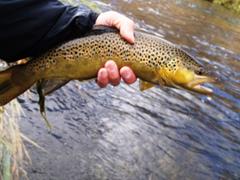 |
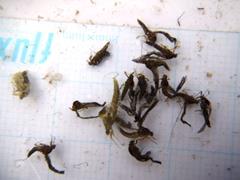 |
| Trout C was nice brown!! | Same contents (note PMD again) |
Answer for curse and paranoia – trout were feeding on drowned duns. Finally I solved the puzzle. Everything came to make sense; the reason for trout feeding in that manner (rise without breaking surface). We know "trout want to eat maximum with minimum effort". Mass of drowned duns were floating "3 to 5 inches below the surface", no wonder they didn't care to take my dry-flies all the way above the surface. Twitched/drowned CDC Dun represented wet/drowned duns most likely due to shape and undulation of CDC wings (when wet).
PECULIAR HATCH PROCESS: I caught up with Tom who was on another part of the creek and reported what had happened. Now we figured out trout behavior. Then instead of salutes or Hi-fives, we started discussing "Why were there so many drowned duns?" Most of mayfly nymphs ascend to the surface and then get out from nymphal exoskeleton (commonly called "shuck"). However, certain percentages of nymphs leave their exoskeleton several inches below the surface and swim up to the surface as duns. This had been discussed among observant anglers over the years. Only recently scientists conducted research and confirmed so (please refer EVENING ALONG THE STREAM – PART 3 in Fly Anglers OnLine). The particular individual that I seined and photographed ("3-second-old" dun) really made sense. I was screening three to five inch below the surface. If I hadn't seined it, it would have had left its exoskeleton inches below the surface and emerged as dun.
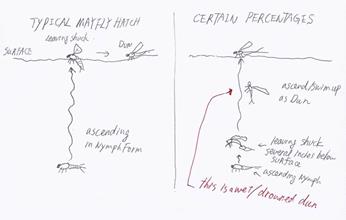
This is a very scientific and persuasive statement, isn't it? However, it's not answering "so many" part as it says "certain percentages". Was that particular batch of BWO at DePuy's genetically programmed so or even defected so? Now we really have to interview some BWOs and interrogate trout as their accomplices.
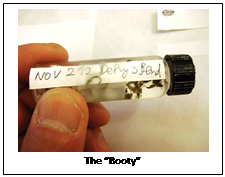 EPILOGUE: The entire experience was Master level angling and indeed "classroom of fly-fishing" that extended for a week. I took notes (my journal), listened to Master Angler, and observed trout and bugs. I wish the early "BWO Happy-Hours" would have lasted longer but the reward after I went through this hardship is priceless. Just to add more tastes to the whole story, November 2nd was indeed the last big BWO hatch for the season. After that BWO were still hanging around, and when conditions were right I could take trout with dry-flies in normal presentations as trout were breaking the surface. How lucky and cursed could I be?
EPILOGUE: The entire experience was Master level angling and indeed "classroom of fly-fishing" that extended for a week. I took notes (my journal), listened to Master Angler, and observed trout and bugs. I wish the early "BWO Happy-Hours" would have lasted longer but the reward after I went through this hardship is priceless. Just to add more tastes to the whole story, November 2nd was indeed the last big BWO hatch for the season. After that BWO were still hanging around, and when conditions were right I could take trout with dry-flies in normal presentations as trout were breaking the surface. How lucky and cursed could I be?
So have I earned a Masters in Spring Creek Angling then? Not yet. Perhaps I earned a "high school diploma" at this point. I solved only one particular situation at one spot. "Learning and observation will never end" is one of first mantras Tom gave me. I am saving the vial filled with stomach sample of "Trout A" at my tying bench so I can reach and observe it any time. I will come up with new fly designs any time soon. Oh, by the way, the CDC Dun that all three trout chose was on a 5x leader. Even during paranoia and fear, I actually never thought the tippet size would be a problem. I didn't think of what most of anglers claim "spring creek trout are educated and out-smarting us!!" Trout were simply doing what they were supposed to do = eat as many BWO as possible = with the least energy consuming movement. In order to get to the point, keyword is again and will always be "observation".
Perhaps "I need three more years before I can think like a fish" and "I already know how to think like a wet BWO dun" (quoted from the last conversation between brothers in "A River Runs Through It"). Perhaps so………
Satoshi Yamamoto, http://leftyangler.blogspot.com, brought his passion for fly-fishing & fly-tying from Japan to Montana and became the first ever Japanese guide in Livingston, MT. He guides and fishes big rivers like Madison & Yellowstone, spring creeks in Paradise Valley, and various waters in Yellowstone Park. Hence, with his Regal Vise at the bench, his fly tying interests vary from tiny midges to 5-inch streamers and anything in between. Once his ideas are combined he goes out for experiments at those near-by waters. Satoshi submits his innovative patterns to Montana Fly Company (www.montanafly.com).
His own innovative original patterns can be purchased from his fly-shop, http://leftytyer.blogspot.com.
